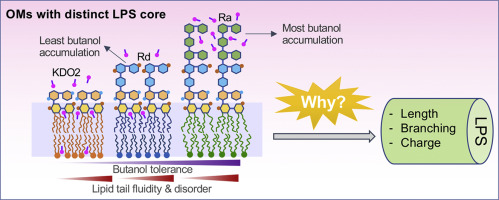当前位置:
X-MOL 学术
›
BBA Biomembr.
›
论文详情
Our official English website, www.x-mol.net, welcomes your feedback! (Note: you will need to create a separate account there.)
Bacterial lipopolysaccharide core structures mediate effects of butanol ingress.
Biochimica et Biophysica Acta (BBA) - Biomembranes ( IF 3.4 ) Pub Date : 2019-12-09 , DOI: 10.1016/j.bbamem.2019.183150 Jingjing Guo 1 , Geraldine W N Chia 2 , Nikolay V Berezhnoy 2 , Amaury Cazenave-Gassiot 3 , Staffan Kjelleberg 4 , Jamie Hinks 2 , Yuguang Mu 5 , Thomas Seviour 2
Biochimica et Biophysica Acta (BBA) - Biomembranes ( IF 3.4 ) Pub Date : 2019-12-09 , DOI: 10.1016/j.bbamem.2019.183150 Jingjing Guo 1 , Geraldine W N Chia 2 , Nikolay V Berezhnoy 2 , Amaury Cazenave-Gassiot 3 , Staffan Kjelleberg 4 , Jamie Hinks 2 , Yuguang Mu 5 , Thomas Seviour 2
Affiliation

|
The outer membrane (OM) is the first defence for Gram-negative bacteria against their environments making it important in strain improvement for sustainable biobutanol production. While modifying the OM structure using chemical additives could enhance microbial viability, there are currently no model systems that accurately describe OM responses to butanol. Here, we experimentally determined that reducing the lipopolysaccharide (LPS) core length and charge increased Escherichia coli sensitivity to butanol. In silico models were built to describe how OM structure contributes to its ability to withstand butanol under conditions of exposure and production. Consistent with experiments, resistance to ingress of butanol into OMs correlates with both core length and charge, where a lower charge density is more conducive to butanol assimilation. The core length and branching correlate with the lateral spacing of the lipids, suggestive of a role of them in maintaining OM fluidity. In contrast to systems with short-length LPS cores, butanol intercalation into OMs with longer LPS cores increases membrane order and rigidity, which might be due to their more porous internal structure. These findings will assist the development of more butanol-tolerant biobutanol-producing bacteria, where thicker, more compact and less polar LPS-core surfaces reinforce the integrity of OMs and further improve resilience in extreme environments.
中文翻译:

细菌脂多糖核心结构介导丁醇进入的作用。
外膜(OM)是革兰氏阴性细菌抵御其环境的第一道防线,因此在菌株改良中非常重要,以可持续地生产生物丁醇。尽管使用化学添加剂修饰OM结构可以增强微生物的生存能力,但目前尚没有模型系统可以准确描述OM对丁醇的反应。在这里,我们实验确定减少脂多糖(LPS)的核心长度和电荷增加大肠杆菌对丁醇的敏感性。建立了计算机模拟模型,以描述OM结构如何在暴露和生产条件下提高其抵抗丁醇的能力。与实验一致,丁醇进入OM的阻力与核长和电荷都相关,其中较低的电荷密度更有利于丁醇的同化。核心长度和分支与脂质的横向间距相关,表明它们在维持OM流动性中的作用。与具有短长度LPS芯的系统相比,丁醇插入具有更长LPS芯的OM中会增加膜的有序性和刚性,这可能是由于其内部结构更加多孔所致。这些发现将有助于开发更多具有丁醇耐受性的生物丁醇生产细菌,其中更厚,更紧凑且极性更小的LPS核心表面可增强OM的完整性,并进一步提高在极端环境中的弹性。这可能是由于其内部结构更加多孔。这些发现将有助于开发更多具有丁醇耐受性的生物丁醇生产细菌,其中更厚,更紧凑且极性更小的LPS核心表面可增强OM的完整性,并进一步提高在极端环境中的弹性。这可能是由于其内部结构更加多孔。这些发现将有助于开发更多具有丁醇耐受性的生物丁醇生产细菌,其中更厚,更紧凑且极性更小的LPS核心表面可增强OM的完整性,并进一步提高在极端环境中的弹性。
更新日期:2019-12-09
中文翻译:

细菌脂多糖核心结构介导丁醇进入的作用。
外膜(OM)是革兰氏阴性细菌抵御其环境的第一道防线,因此在菌株改良中非常重要,以可持续地生产生物丁醇。尽管使用化学添加剂修饰OM结构可以增强微生物的生存能力,但目前尚没有模型系统可以准确描述OM对丁醇的反应。在这里,我们实验确定减少脂多糖(LPS)的核心长度和电荷增加大肠杆菌对丁醇的敏感性。建立了计算机模拟模型,以描述OM结构如何在暴露和生产条件下提高其抵抗丁醇的能力。与实验一致,丁醇进入OM的阻力与核长和电荷都相关,其中较低的电荷密度更有利于丁醇的同化。核心长度和分支与脂质的横向间距相关,表明它们在维持OM流动性中的作用。与具有短长度LPS芯的系统相比,丁醇插入具有更长LPS芯的OM中会增加膜的有序性和刚性,这可能是由于其内部结构更加多孔所致。这些发现将有助于开发更多具有丁醇耐受性的生物丁醇生产细菌,其中更厚,更紧凑且极性更小的LPS核心表面可增强OM的完整性,并进一步提高在极端环境中的弹性。这可能是由于其内部结构更加多孔。这些发现将有助于开发更多具有丁醇耐受性的生物丁醇生产细菌,其中更厚,更紧凑且极性更小的LPS核心表面可增强OM的完整性,并进一步提高在极端环境中的弹性。这可能是由于其内部结构更加多孔。这些发现将有助于开发更多具有丁醇耐受性的生物丁醇生产细菌,其中更厚,更紧凑且极性更小的LPS核心表面可增强OM的完整性,并进一步提高在极端环境中的弹性。


























 京公网安备 11010802027423号
京公网安备 11010802027423号